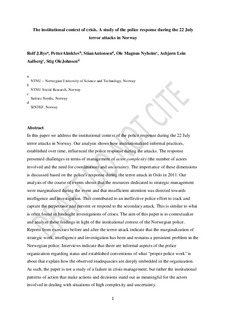| dc.contributor.author | Bye, Rolf Johan | |
| dc.contributor.author | Almklov, Petter Grytten | |
| dc.contributor.author | Antonsen, Stian | |
| dc.contributor.author | Nyheim, Ole Magnus | |
| dc.contributor.author | Aalberg, Asbjørn Lein | |
| dc.contributor.author | Johnsen, Stig Ole | |
| dc.date.accessioned | 2019-03-01T10:12:05Z | |
| dc.date.available | 2019-03-01T10:12:05Z | |
| dc.date.created | 2018-10-01T13:51:50Z | |
| dc.date.issued | 2018 | |
| dc.identifier.citation | Safety Science. 2018, 111 67-79. | nb_NO |
| dc.identifier.issn | 0925-7535 | |
| dc.identifier.uri | http://hdl.handle.net/11250/2588216 | |
| dc.description.abstract | In this paper we address the institutional context of the police response during the 22 July terror attacks in Norway. Our analysis shows how institutionalized informal practices, established over time, influenced the police response during the attacks. The response presented challenges in terms of management of actor complexity (the number of actors involved and the need for coordination) and uncertainty. The importance of these dimensions is discussed based on the police's response during the terror attack in Oslo in 2011. Our analysis of the course of events shows that the resources dedicated to strategic management were marginalized during the event and that insufficient attention was directed towards intelligence and investigation. This contributed to an ineffective police effort to track and capture the perpetrator and prevent or respond to the secondary attack. This is similar to what is often found in hindsight investigations of crises. The aim of this paper is to contextualize and analyze these findings in light of the institutional context of the Norwegian police. Reports from exercises before and after the terror attack indicate that the marginalization of strategic work, intelligence and investigation has been and remains a persistent problem in the Norwegian police. Interviews indicate that there are informal aspects of the police organization regarding status and established conventions of what “proper police work” is about that explain how the observed inadequacies are deeply embedded in the organization. As such, the paper is not a study of a failure in crisis management, but rather the institutional patterns of action that make actions and decisions stand out as meaningful for the actors involved in dealing with situations of high complexity and uncertainty. | nb_NO |
| dc.language.iso | eng | nb_NO |
| dc.publisher | Elsevier | nb_NO |
| dc.relation.uri | https://www.sciencedirect.com/science/article/pii/S0925753518304168?via%3Dihub | |
| dc.rights | Attribution-NonCommercial-NoDerivatives 4.0 Internasjonal | * |
| dc.rights.uri | http://creativecommons.org/licenses/by-nc-nd/4.0/deed.no | * |
| dc.title | The institutional context of crisis. A study of the police response during the 22 July terror attacks in Norway | nb_NO |
| dc.type | Journal article | nb_NO |
| dc.type | Peer reviewed | nb_NO |
| dc.description.version | acceptedVersion | nb_NO |
| dc.source.pagenumber | 67-79 | nb_NO |
| dc.source.volume | 111 | nb_NO |
| dc.source.journal | Safety Science | nb_NO |
| dc.identifier.doi | 10.1016/j.ssci.2018.09.011 | |
| dc.identifier.cristin | 1616782 | |
| dc.relation.project | Norges forskningsråd: 234391 | nb_NO |
| dc.description.localcode | © 2018. This is the authors’ accepted and refereed manuscript to the article. Locked until 01.10.2021 due to copyright restrictions. This manuscript version is made available under the CC-BY-NC-ND 4.0 license http://creativecommons.org/licenses/by-nc-nd/4.0/ | nb_NO |
| cristin.unitcode | 194,67,45,0 | |
| cristin.unitname | Institutt for sosialantropologi | |
| cristin.ispublished | true | |
| cristin.fulltext | postprint | |
| cristin.qualitycode | 1 | |

